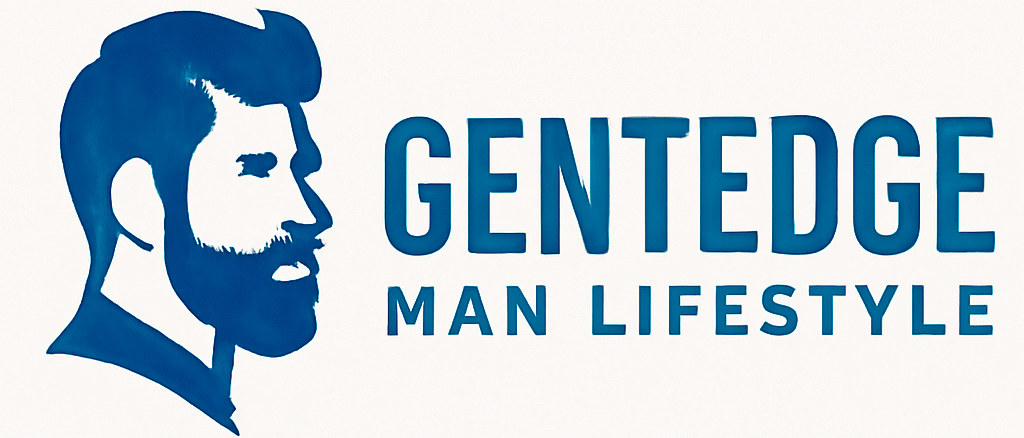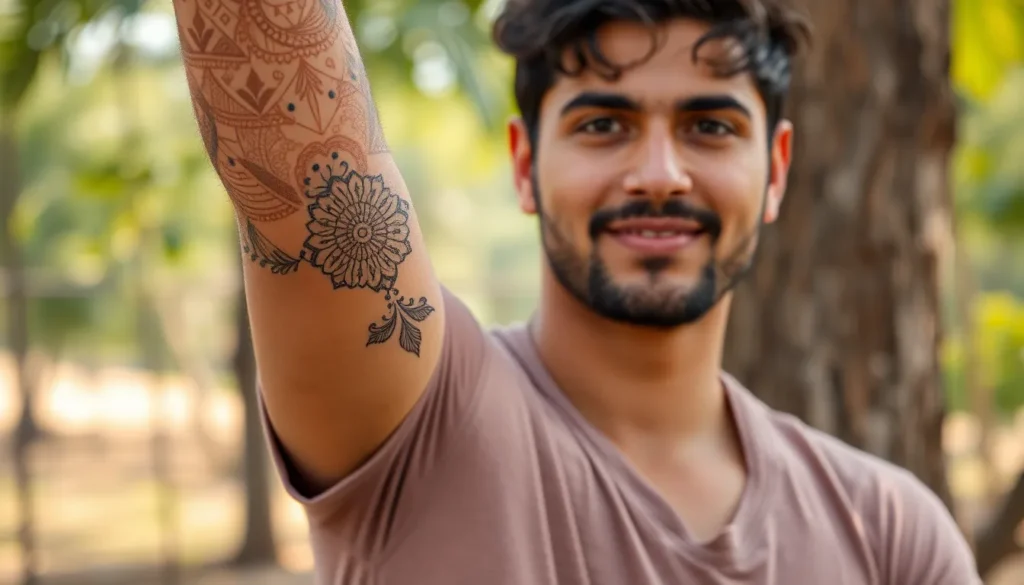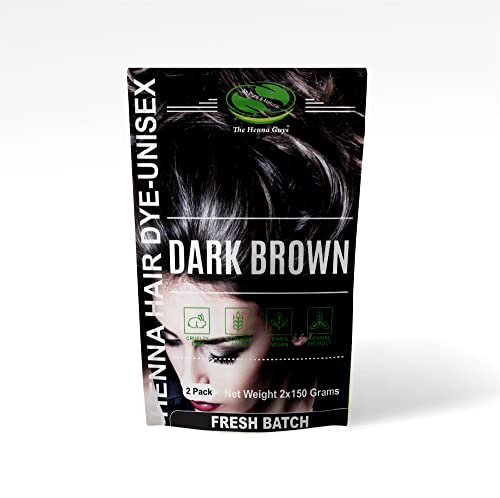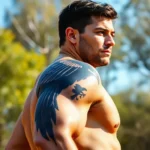Men’s interest in henna tattoos has exploded in recent years as more guys discover this ancient art form’s masculine appeal. We’ve seen countless men embrace temporary body art that lets them express their style without permanent commitment.
Henna isn’t just for women anymore. Today’s male-focused designs range from bold geometric patterns and tribal motifs to intricate mandala artwork that showcases strength and sophistication. Whether you’re testing out a future tattoo idea or simply want to make a statement at your next event, henna offers the perfect solution.
We’ll explore the most popular henna designs specifically crafted for men, covering everything from traditional patterns to modern interpretations. You’ll discover placement ideas that complement masculine aesthetics and learn why so many guys are choosing henna as their go-to temporary body art option.
Traditional Geometric Henna Patterns for Men
Traditional geometric patterns represent the foundation of masculine henna artistry. We’ve seen these timeless designs gain tremendous popularity among men seeking sophisticated temporary body art.
Mandala-Inspired Circular Designs
Mandala patterns offer men powerful symbolic meaning through intricate circular geometry. We recommend starting with simple concentric circles and building complexity with radiating lines, dots, and geometric shapes that flow outward from a central point.
Popular mandala variations for men include:
- Bold compass-style designs with sharp angular points
- Geometric flower patterns featuring triangular petals
- Celtic knot inspired circular motifs with interwoven lines
- Aztec sun designs incorporating stepped pyramid elements
Placement options work best on:
- Upper arms and shoulders for maximum visual impact
- Chest areas where the circular shape complements natural body curves
- Back surfaces that provide ample space for larger designs
- Palms for smaller, more intimate geometric patterns
Tribal Geometric Motifs
Tribal geometric designs combine ancient cultural significance with modern masculine appeal. We’ve observed these patterns work exceptionally well for men due to their bold lines and powerful visual presence.
Key tribal geometric elements include:
- Chevron patterns creating ever-changing zigzag formations
- Diamond shapes arranged in repeating sequences
- Arrow motifs pointing in directional patterns
- Interlocking triangular designs forming complex networks
Cultural inspirations draw from:
- Polynesian tribal patterns featuring thick black lines
- Native American geometric designs with stepped formations
- African tribal motifs incorporating repetitive diamond shapes
- Celtic geometric patterns with intricate knotwork elements
Sacred Geometry Symbols
Sacred geometry symbols provide men with meaningful henna designs rooted in mathematical perfection. We find these patterns particularly appealing to men interested in spiritual symbolism and precise geometric forms.
Essential sacred geometry patterns feature:
- Flower of Life designs with overlapping circles
- Metatron’s Cube incorporating complex hexagonal structures
- Golden ratio spirals creating natural flowing movements
- Platonic solid representations through geometric line work
- Unity and interconnectedness through overlapping circular patterns
- Balance and harmony via symmetrical geometric arrangements
- Spiritual growth represented through ascending triangular forms
- Protection symbols created through interlocking geometric shields
Bold Arm and Forearm Henna Designs
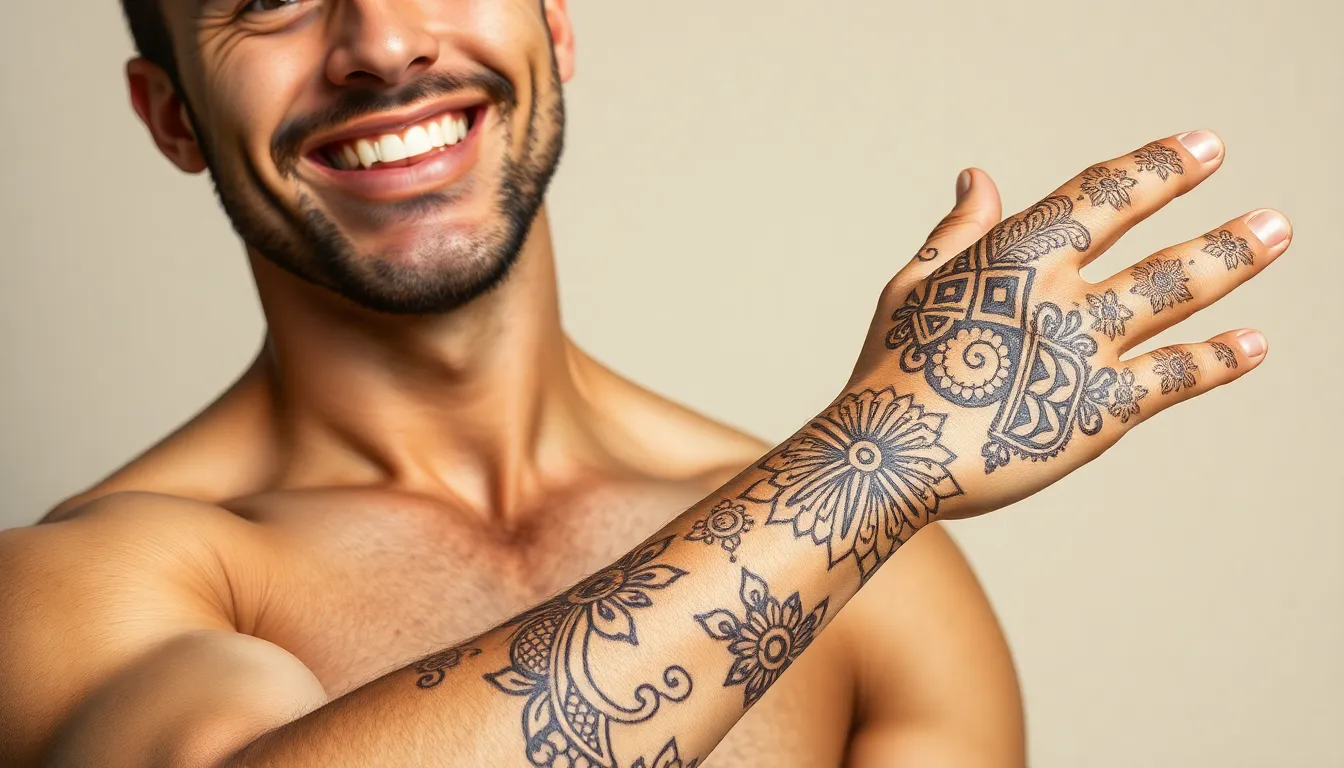
Arms and forearms offer prime real estate for masculine henna artistry, where bold lines and striking patterns make powerful statements. We’ve seen geometric, tribal, and minimalist designs dominate these placements due to their visibility and design flexibility.
Full Sleeve Patterns
Full sleeve henna tattoos create dramatic visual impact by covering the entire arm from wrist to shoulder. These comprehensive designs typically incorporate tribal motifs, abstract patterns, or nature-inspired themes that flow seamlessly together. Thick lines and detailed dot work form the foundation of most sleeve patterns, creating cohesive artwork that commands attention.
Interconnected patterns work exceptionally well for sleeve designs, allowing each element to blend naturally into the next. Abstract themes give us creative freedom to experiment with bold geometric shapes and flowing curves. Nature-inspired motifs like vines, leaves, or wave patterns add organic movement to the overall composition.
Wrist Band Designs
Wrist band henna tattoos provide simplicity and versatility for men seeking understated elegance. These designs encircle the wrist with thick bands that often feature tribal motifs, geometric shapes, or subtle embellishments. Easy application and maintenance make wrist bands particularly appealing for first-time henna wearers.
Thick bands create strong visual anchor points that draw attention without overwhelming the overall look. Tribal motifs within these bands add cultural depth and masculine appeal. Geometric shapes offer clean lines and modern aesthetics that complement contemporary style preferences.
Bicep and Shoulder Motifs
Bicep and shoulder placements showcase large, bold motifs that highlight muscular definition and create striking focal points. These areas accommodate tribal symbols, mandalas, and abstract patterns that wouldn’t fit on smaller body parts. We often recommend these placements for special events or occasions where dramatic impact is desired.
Large canvases allow for more detailed and ever-changing artwork that truly showcases the artist’s skill. Bold motifs in these areas create natural conversation starters and demonstrate confidence in personal style choices. Abstract patterns give us flexibility to create unique designs that reflect individual personality and preferences.
Masculine Hand and Finger Henna Art

Hand and finger henna designs offer men the perfect canvas for showcasing bold, geometric artistry. These placements emphasize symmetry-driven patterns and tribal motifs that complement masculine aesthetics.
Knuckle Designs
Knuckle tattoos create striking visual impact through vertical or horizontal bands that wrap around each joint. We see men gravitating toward intricate knot patterns and mandala motifs that highlight the natural contours of their hands. Angular shapes and abstract designs add a modern, edgy aesthetic that sets these tattoos apart from traditional feminine patterns.
Vertical band designs work exceptionally well on knuckles because they follow the natural movement of fingers. Horizontal patterns create bold statements across all four knuckles simultaneously. Many men choose interconnected designs that flow from one knuckle to the next, creating cohesive artwork across their entire hand.
Palm Center Patterns
Palm center designs focus on eye-catching central motifs that radiate outward in balanced compositions. We recommend geometric mandalas, crosses, and dot patterns that use negative space for maximum contrast and clarity. These designs draw attention to the palm’s natural focal point while maintaining masculine appeal.
Central mandala patterns work particularly well because they can incorporate tribal elements and bold lines. Dot matrix designs create geometric precision that appeals to men who prefer minimalist aesthetics. Cross motifs offer both decorative and symbolic significance, often representing personal beliefs or cultural heritage.
Finger Ring Tattoos
Finger ring tattoos form continuous bands around each digit, creating the illusion of permanent jewelry. We see men choosing designs embellished with dots, lines, and small symbols that reflect their personal style. These temporary rings allow experimentation with different patterns before committing to permanent alternatives.
Tribal-inspired bands feature straight lines and angular shapes rather than flowing, floral elements. Cultural motifs draw from various traditions, incorporating meaningful symbols that resonate with individual heritage. Customized text, dates, and small icons add personal significance to these wearable art pieces that last one to three weeks depending on skin type and aftercare.
Cultural and Religious Henna Symbols
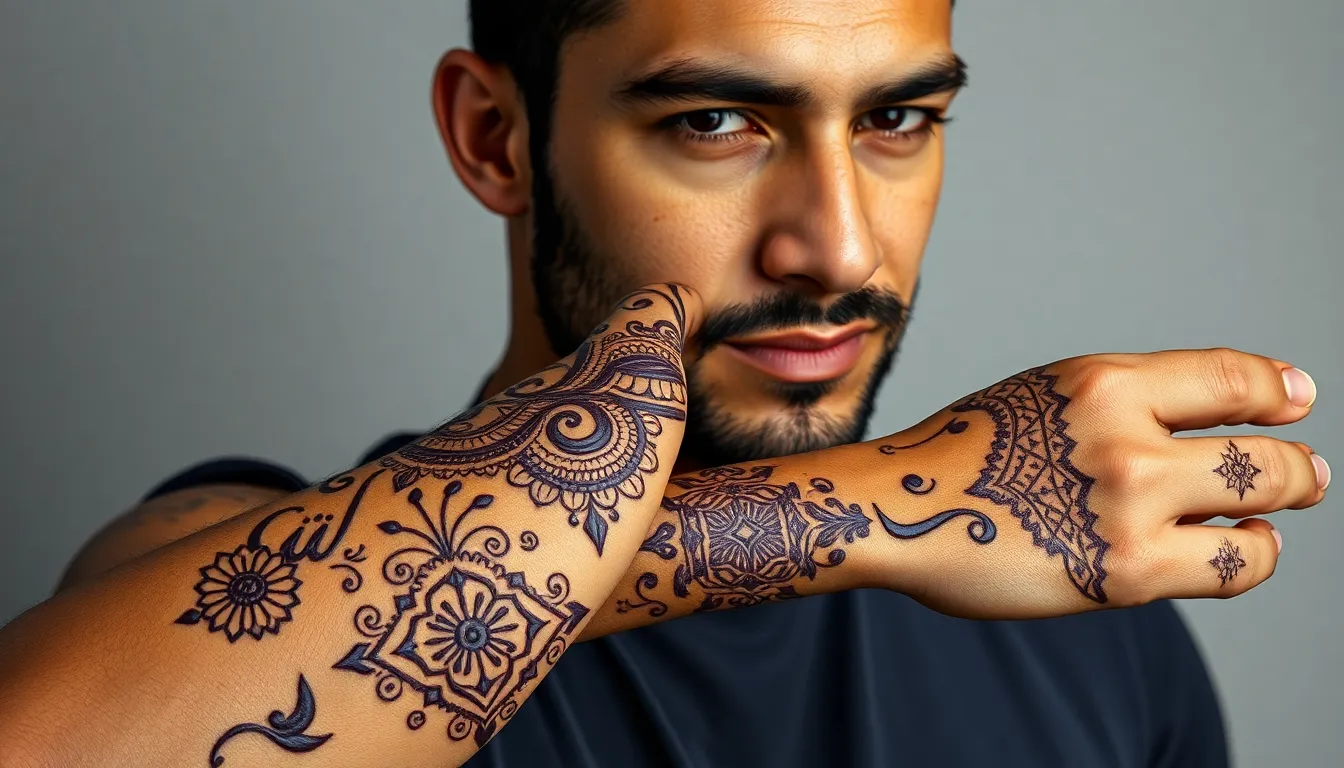
While geometric patterns form the foundation of masculine henna artistry, cultural and religious symbols add profound meaning to our designs. These sacred motifs connect modern men to ancient spiritual traditions.
Arabic Calligraphy Designs
Arabic calligraphy transforms henna into elegant storytelling through flowing script patterns. We see these designs emphasizing large floral motifs that create striking visual balance on masculine skin. Abstract patterns interweave with meaningful verses from the Quran or phrases celebrating good fortune and prosperity.
Flowing Arabic script works exceptionally well across broad surfaces like forearms and chest areas. Men appreciate these designs for their sophisticated appearance and spiritual significance. Calligraphy patterns feature less density than traditional Indian henna styles, creating clean lines that complement masculine aesthetics.
Modern Arabic henna incorporates geometric borders that frame the central script beautifully. We recommend combining these designs with subtle paisley elements that symbolize luck and fertility in Middle Eastern cultures.
Hindu and Buddhist Symbols
Spiritual symbols from Hindu and Buddhist traditions offer powerful meanings for men seeking deeper connections. Mandalas represent our spiritual unity with the universe while creating visually stunning circular patterns. These designs work perfectly for shoulder placements and back pieces where their intricate details can fully develop.
Lotus flowers symbolize purity and spiritual growth, making them popular choices for men on groundbreaking journeys. We often see these paired with other sacred elements like peacocks, which represent beauty and spirituality in Hindu culture. Sahasrara symbols represent the crown chakra, connecting wearers to divine purity and universal consciousness.
Birds serve as messengers between heaven and earth in these traditions. Swans particularly symbolize success and grace, while general bird motifs create ever-changing movement in henna compositions. These elements combine beautifully with geometric backgrounds for balanced masculine designs.
Celtic Knot Variations
Celtic knots bring unique European symbolism to traditional henna artistry through their intricate interwoven patterns. We adapt these ancient symbols to complement the spiritual themes found in Eastern henna traditions. Eternity knots represent endless cycles and infinite connections, appealing to men who value permanence and unity concepts.
Interconnected Celtic patterns symbolize the bonds between all living things. These designs work exceptionally well when combined with mandala elements or geometric borders. We recommend placing Celtic inspired henna on areas where the continuous lines can flow naturally, such as around the bicep or across the chest.
Unity symbols from Celtic tradition emphasize our connections to family, community, and nature. Modern interpretations blend traditional knot work with contemporary geometric elements, creating designs that honor both ancient wisdom and current aesthetic preferences.
Nature-Inspired Henna Tattoos for Men
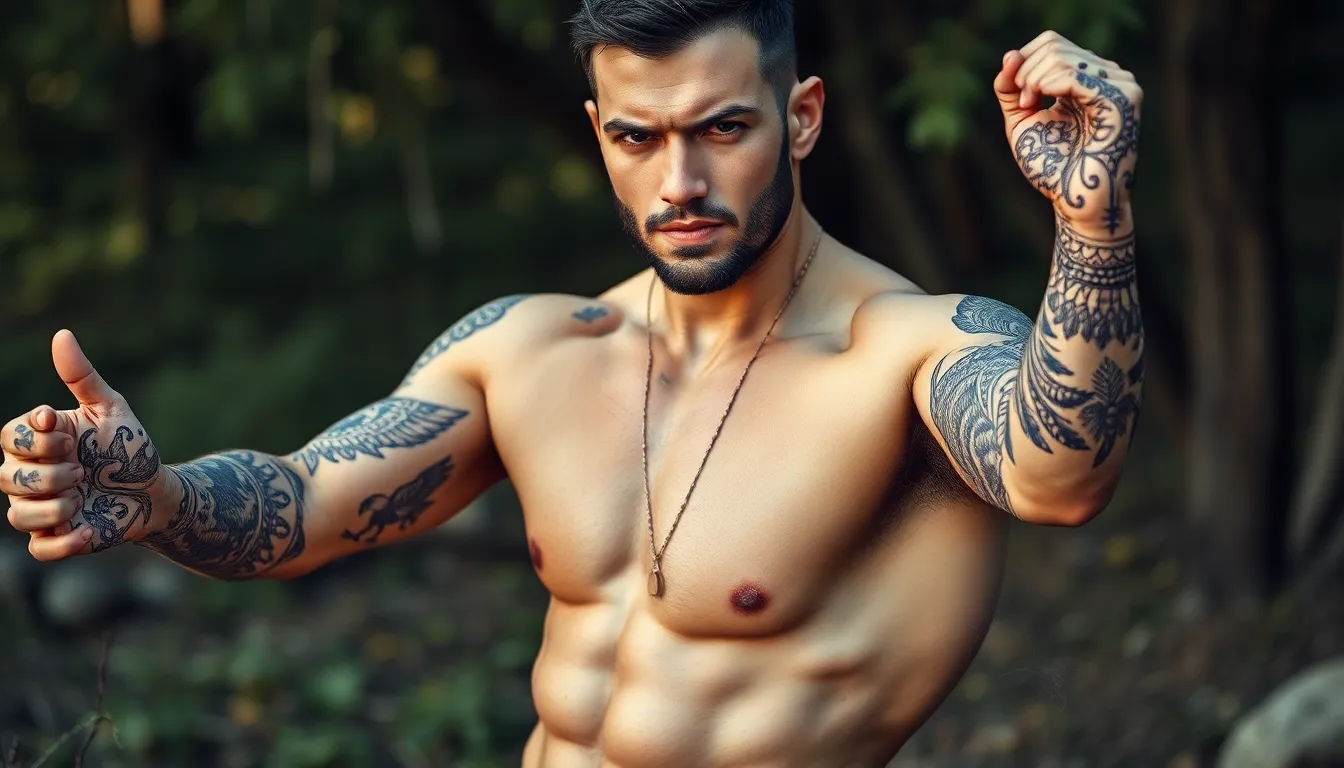
Drawing from the natural industry creates some of the most powerful and meaningful henna designs for men. We find that nature motifs resonate deeply with masculine energy while offering rich symbolic connections to strength and spiritual growth.
Animal Motifs and Totems
Wolves emerge as the most popular animal choice for masculine henna designs, representing loyalty, leadership, and pack mentality. Eagles soar through detailed wing patterns that wrap around biceps and forearms, symbolizing courage and freedom in their majestic flight. Snakes coil elegantly around wrists and arms, embodying transformation and renewal through their shedding cycles.
Bears command attention with bold silhouettes that showcase raw power and protective instincts. Lions roar through intricate mane details that flow across chest and shoulder placements, representing strength and nobility. Tigers prowl through striped patterns that emphasize their fierce independence and hunting prowess.
Ravens and hawks create striking focal points with outstretched wings that span across back shoulders. Deer antlers branch into geometric patterns, connecting masculine energy with natural wisdom. Elephants trumpet through trunk designs that spiral around arms, bringing good fortune and memory symbolism.
Tree and Leaf Patterns
Oak trees root deeply into forearm designs, their branches reaching toward shoulders in symbols of endurance and wisdom. Pine trees stand tall in minimalist silhouettes that emphasize stability and evergreen persistence. Maple leaves cascade down arms in autumn patterns, representing change and natural beauty cycles.
Celtic tree of life motifs interweave branches and roots in circular patterns that work perfectly for chest placements. Bamboo stalks grow vertically along spine designs, symbolizing flexibility and resilience under pressure. Fern patterns unfurl across shoulder blades, bringing ancient forest energy to modern masculinity.
Banyan tree designs spread their aerial roots across back canvases, creating complex networks that represent interconnectedness. Willow branches drape gracefully around ribs, embodying adaptability and emotional depth. Cherry blossom branches bloom across biceps, balancing masculine strength with natural beauty.
Mountain and Wave Designs
Mountain ranges peak across chest and back designs, their jagged silhouettes representing stability and unwavering determination. Alpine peaks climb up forearms in minimalist line work, creating clean geometric shapes that emphasize masculine angles. Volcanic mountains erupt with flowing lava patterns that blend solid earth with ever-changing movement.
Ocean waves crash along arm bands and wrist placements, their flowing curves balancing the rigid mountain structures above. Tsunami waves surge across shoulder designs, representing overwhelming power and natural force. River currents meander through valley patterns, connecting mountain bases with flowing water elements.
Rocky cliff faces create dramatic backdrop designs that showcase endurance against natural elements. Waterfall cascades tumble from mountain peaks, blending solid stone with liquid movement in vertical compositions. Desert dunes roll across ribcage placements, their curved lines offering softer alternatives to sharp mountain edges.
Modern Minimalist Henna Styles
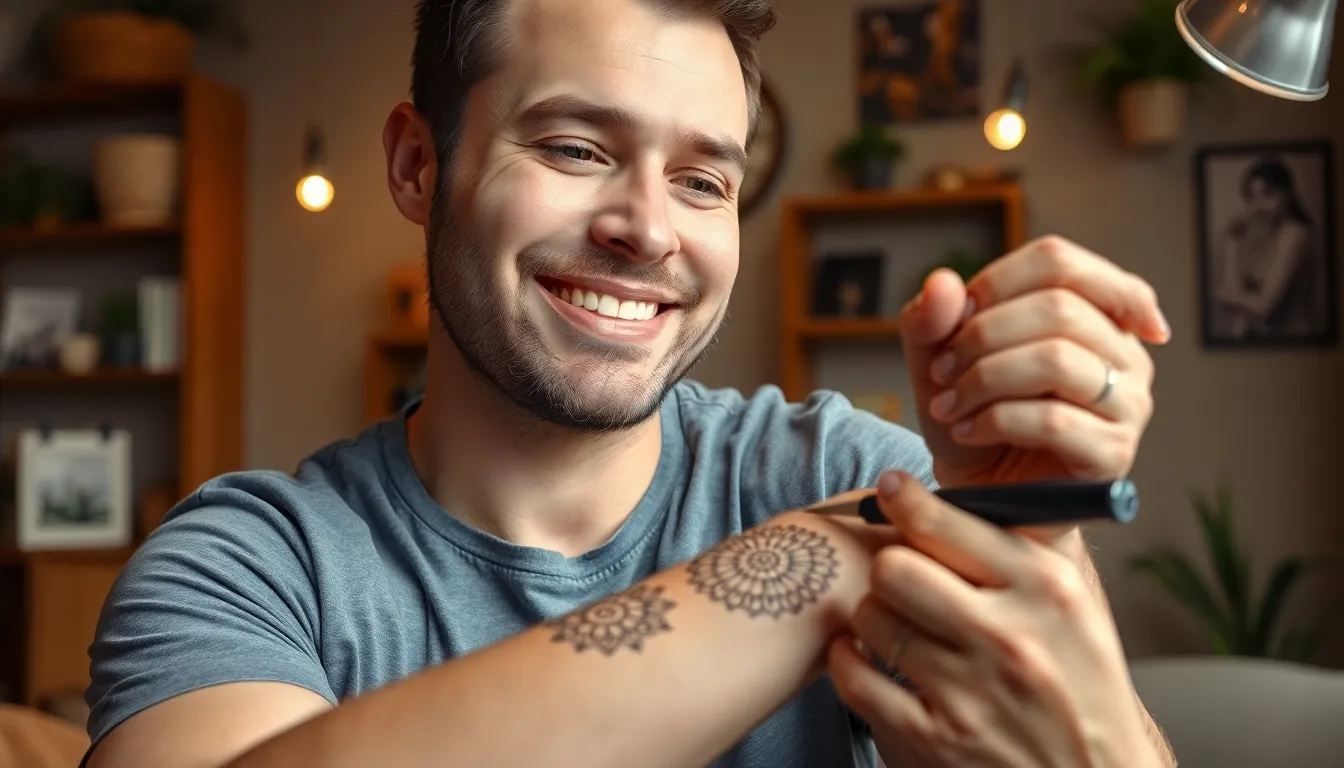
Moving away from intricate traditional patterns, we see more men embracing sleek, understated henna designs that make powerful statements through simplicity. These contemporary styles offer sophisticated alternatives that work perfectly in professional settings while maintaining masculine appeal.
Simple Line Work
Continuous line patterns create stunning visual impact through their elegant simplicity and precise execution. We recommend starting with basic geometric shapes like triangles, diamonds, or hexagons that flow seamlessly across the skin. Single-line mandalas offer a modern twist on traditional circular designs, using unbroken strokes to create mesmerizing patterns around the wrist or forearm.
Interconnected linear motifs work exceptionally well for men who prefer subtle body art that doesn’t overwhelm their natural features. Popular choices include mountain range silhouettes, arrow sequences, and wave patterns that follow the natural contours of muscles. These designs typically take 30-45 minutes to apply and create sharp, clean aesthetics that photograph beautifully.
Parallel line arrangements add depth and dimension without requiring complex shading techniques. We often see men choosing ladder patterns, barcode-inspired designs, or simple stripe sequences that wrap around fingers, wrists, or forearms. The key lies in maintaining consistent spacing and thickness throughout the design.
Small Symbol Tattoos
Minimalist symbols pack maximum meaning into compact designs that work perfectly for first-time henna enthusiasts. Popular choices include compass roses on palms, infinity symbols on wrists, and small anchors on fingers that represent stability and strength. These designs typically measure 1-2 inches and fade naturally over 2-3 weeks.
Dot work patterns create sophisticated textures through strategic placement of small circles or points. We see increasing demand for constellation patterns that map favorite star formations, simple dot mandalas, or stippling techniques that create gradient effects. These styles work exceptionally well on knuckles, behind ears, or along the side of hands.
Single element designs focus on one powerful symbol rather than complex compositions. Men frequently choose lone wolves, single feathers, small trees, or architectural elements like bridges or buildings. The beauty lies in the symbol’s ability to tell a complete story through minimal visual elements.
Contemporary Abstract Patterns
Fluid organic shapes bring artistic flair to modern henna applications without following traditional geometric rules. We create flowing forms that resemble ink drops, paint splatters, or watercolor effects using varying line weights and densities. These designs work particularly well on forearms where they can follow muscle definition naturally.
Asymmetrical compositions challenge conventional henna symmetry while maintaining visual balance through careful weight distribution. Popular approaches include off-center spirals, irregular polygon clusters, or cascading elements that create ever-changing movement across the skin. These styles appeal to men seeking unique, conversation-starting body art.
Negative space utilization creates striking contrasts by leaving strategic areas uncovered within larger designs. We achieve this through hollow shapes, cut-out effects, or interlocking patterns that create optical illusions. The technique works exceptionally well for shoulder pieces or large forearm designs where the contrast between decorated and natural skin creates dramatic visual impact.
Chest and Back Henna Masterpieces
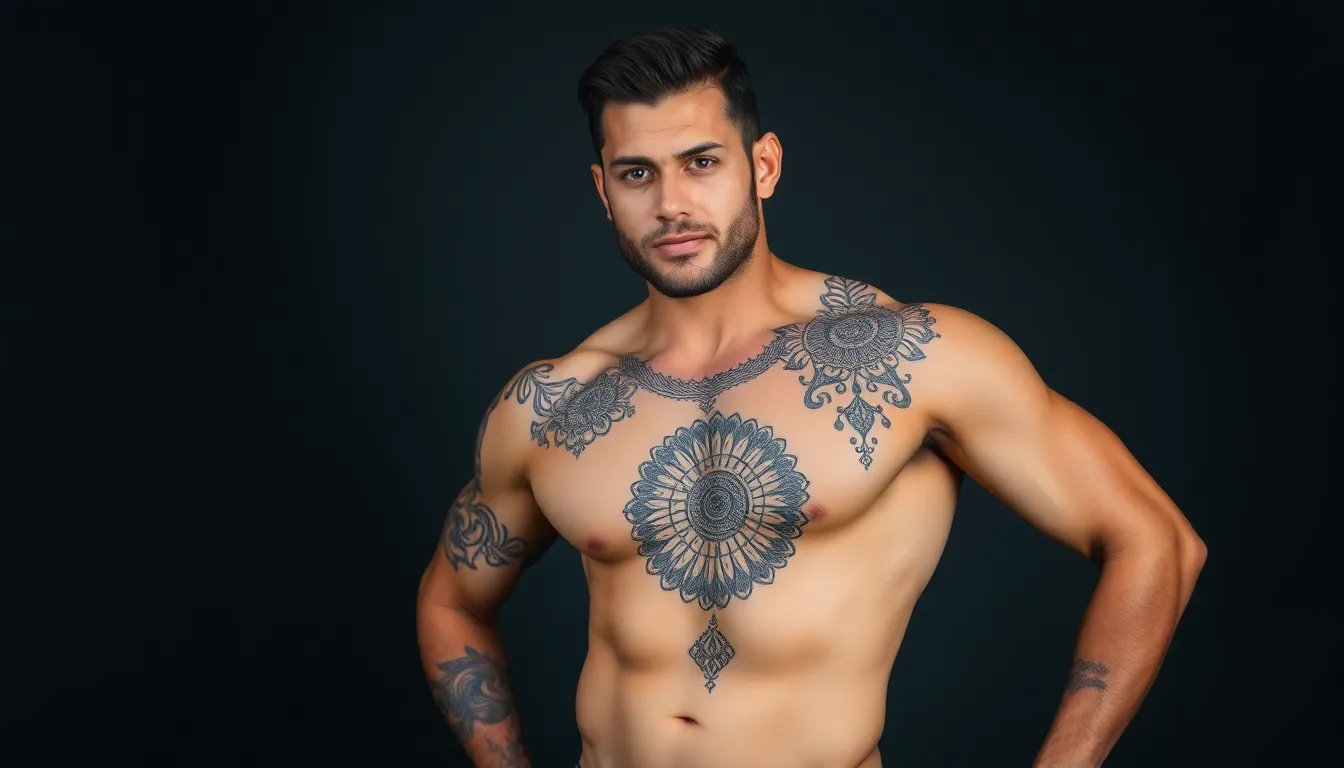
Men’s henna tattoos reach their full artistic potential when applied to the chest and back, where expansive canvases allow for bold, intricate designs that enhance masculine features. These large-scale artworks create commanding visual impacts while maintaining the temporary, painless nature that makes henna appealing to modern men.
Large-Scale Tribal Designs
Tribal henna tattoos dominate chest and back applications through their thick lines, geometric shapes, and culturally important symbols. We see these expansive pieces covering broad areas to create powerful visual statements that reflect personal or ancestral identity. Bold chevron patterns, interlocking diamonds, and sacred arrows form the foundation of these commanding designs.
Geometric tribal motifs often incorporate elements like warrior shields, ceremonial masks, and totemic animals that span the entire chest area. Thick black lines create dramatic contrast against skin while maintaining the authentic tribal aesthetic that resonates with men seeking meaningful body art. Cultural symbols from various traditions blend seamlessly in these large-scale applications, allowing for personalized storytelling through ancient motifs.
Traditional Pacific Islander patterns work exceptionally well for chest coverage, featuring interconnected spirals and wave-like formations that follow the body’s natural contours. African-inspired tribal designs incorporate bold geometric borders and central focal points that draw attention to the chest’s muscular definition.
Symmetrical Chest Patterns
Symmetrical henna designs on the chest offer harmonious balance through patterns that radiate outward from the sternum. We recommend mandala-inspired motifs, ornate lines, and repetitive geometric elements that accentuate the chest’s natural shape while creating visual symmetry. These balanced designs appeal to men who appreciate mathematical precision in their body art.
Central focal points like compass roses or sun symbols serve as anchors for symmetrical patterns that extend across both pectoral areas. Mirrored tribal elements create perfect balance while incorporating personal symbols or cultural motifs that hold significance for the wearer. Radiating line work flows naturally from center points to emphasize the chest’s broad expanse.
Gothic architectural patterns translate beautifully to symmetrical chest designs, featuring pointed arches, geometric windows, and ornamental details that create cathedral-like impressions. Celtic knotwork adapts perfectly to symmetrical applications, with interwoven patterns that symbolize unity and eternal connections while maintaining perfect bilateral balance.
Spine and Shoulder Blade Art
Henna art along the spine incorporates vertical motifs and angular designs that follow the back’s natural lines and highlight muscular definition. We focus on patterns that emphasize the spine’s central column while extending across shoulder blades to create comprehensive back coverage. These designs often combine aesthetic appeal with symbolic meanings like protection, strength, and spiritual guidance.
Vertical tribal patterns work exceptionally well along the spine, featuring totem pole-inspired designs, ceremonial staffs, and sacred columns that create powerful visual narratives. Geometric patterns like stacked diamonds, interconnected triangles, and flowing zigzag lines follow the spine’s natural curve while extending outward to shoulder blade areas.
Dragon motifs prove particularly popular for spine applications, with serpentine bodies following the vertebral column while wings or claws extend across shoulder blades. Tree of life designs offer spiritual symbolism through trunk patterns along the spine and branching elements that spread across the upper back. Feather patterns create flowing vertical lines that incorporate Native American symbolism while highlighting the back’s natural architecture.
Shoulder blade art often features circular mandalas, tribal shields, or wing patterns that complement spine work while standing alone as independent artistic statements. These designs take advantage of the shoulder blade’s flat surface to showcase intricate details and complex geometric patterns that might be lost on curved body areas.
Professional Tips for Long-Lasting Men’s Henna
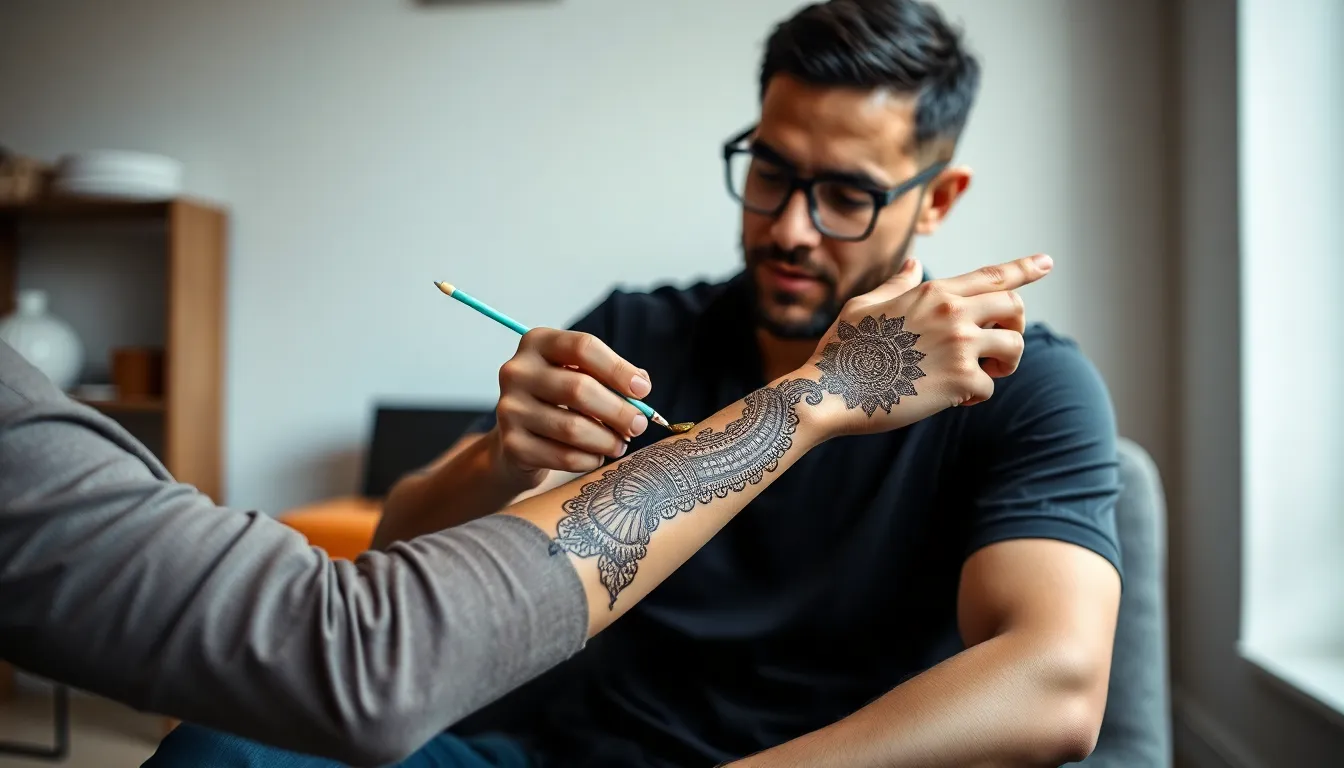
Achieving vibrant, long-lasting henna tattoos requires proper technique and care throughout the entire process. We’ll share the essential professional methods that ensure your masculine henna designs develop into rich, dark stains that last up to three weeks.
Skin Preparation Techniques
Clean the application area thoroughly using soap and water before starting your henna design. This removes oils, dirt, and lotions that create barriers preventing the lawsone dye from penetrating your skin effectively.
Exfoliate gently with a soft scrub or loofah to eliminate dead skin cells from the surface. Fresh skin cells absorb henna dye more readily, resulting in deeper, more vibrant stains that showcase your geometric or tribal patterns beautifully.
Avoid applying moisturizers or oils for at least 24 hours before your henna session. These products form protective layers on your skin that block dye absorption, leading to lighter, shorter-lasting results.
Trim excess hair in the application area if necessary. While not mandatory, shorter hair allows better contact between the henna paste and your skin, ensuring even coverage across your chosen design.
Application Best Practices
Use fresh, natural henna paste for optimal staining results, as it contains the highest concentration of lawsone dye. Fresh paste produces deeper, richer colors that develop into the dark brown stains men prefer for their bold designs.
Apply the paste thickly and evenly across your chosen pattern, ensuring complete coverage of all design elements. Thick application prevents the paste from drying too quickly and allows maximum dye transfer to occur.
Keep the henna paste on your skin for 4 to 6 hours minimum, though overnight application yields the best results. Extended contact time allows the lawsone molecules to fully bind with your skin proteins, creating lasting, vibrant stains.
Avoid smudging the design once the paste begins drying, as this can blur your carefully planned geometric or tribal patterns. Movement should be minimal during the initial drying phase to preserve crisp, clean lines.
Aftercare and Maintenance
Remove the dried paste by scraping, never by washing, to preserve the developing stain underneath. Gentle scraping with a plastic card or your fingernails prevents water from interfering with the chemical bonding process.
Apply a lemon sugar mixture immediately after paste removal to seal and deepen your design. The acidity helps intensify the stain while the sugar creates a protective coating that enhances color development.
Keep the area warm using body heat or gentle warmth sources, as heat improves the chemical binding between the dye and your skin proteins. Warmth activates the staining process and helps achieve the deep, dark colors men desire.
Avoid water contact for 12 hours following paste removal to prevent premature fading. Water exposure during this critical period can wash away the developing stain before it fully sets into your skin.
Apply essential oils such as lavender or tea tree oil, which contain terpenes that aid dye penetration and deepen the final stain color. These oils also provide antimicrobial benefits while improving the longevity of your henna tattoo.
Refrain from exfoliating or scrubbing the tattooed area throughout the henna’s one to three week lifespan. Gentle washing with mild soap preserves your design while allowing natural fading to occur gradually as your skin renews itself.
Conclusion
We’ve explored the incredible versatility and artistic potential that henna offers modern men seeking meaningful temporary body art. From intricate mandala designs to bold tribal motifs this ancient practice has evolved into a sophisticated form of masculine self-expression.
Whether you’re drawn to minimalist line work or elaborate chest pieces henna provides the perfect opportunity to experiment with different styles without permanent commitment. The variety of placements from subtle finger rings to dramatic full sleeves ensures there’s a design approach that matches every personality and lifestyle.
With proper application techniques and aftercare your henna artwork can last weeks while making a powerful statement about your personal style and cultural appreciation. We encourage you to explore these timeless designs and discover how henna can enhance your individual aesthetic.
Frequently Asked Questions
What makes henna tattoos appealing to men?
Henna tattoos offer men a way to express their personal style through bold, masculine designs without the permanence of traditional tattoos. They provide temporary body art that can showcase geometric patterns, tribal motifs, and meaningful symbols while allowing flexibility to change designs based on preferences or occasions.
What are the most popular henna designs for men?
Popular masculine henna designs include bold geometric patterns, tribal motifs, intricate mandalas, sacred geometry symbols, and nature-inspired themes. Men often choose designs featuring wolves, eagles, mountain ranges, Celtic knots, compass roses, and minimalist line work that emphasize strength and masculinity.
Where should men place henna tattoos for maximum impact?
The best placement areas for men’s henna tattoos include upper arms, forearms, chest, back, shoulders, and hands. These locations offer ample space for detailed designs while enhancing muscular definition. Hand and finger placements are particularly popular for their visibility and bold statement-making potential.
How long do men’s henna tattoos typically last?
Men’s henna tattoos generally last 1-3 weeks, depending on placement, skin type, and aftercare. Areas with thicker skin like palms and feet tend to hold the stain longer. Proper preparation, application technique, and following aftercare instructions can significantly extend the tattoo’s lifespan and color intensity.
What’s the difference between traditional and modern minimalist henna styles?
Traditional henna features intricate patterns, cultural symbols, and detailed geometric designs, while modern minimalist styles focus on clean lines, simple symbols, and understated elegance. Minimalist designs are perfect for professional settings and offer sophisticated alternatives through continuous line work and strategic use of negative space.
Can henna tattoos incorporate cultural and religious symbols?
Yes, henna tattoos can feature various cultural and religious symbols including Arabic calligraphy, Hindu and Buddhist motifs like mandalas and lotus flowers, and Celtic knots. These designs connect wearers to ancient spiritual traditions while providing meaningful personal expression through sacred symbolism.
What aftercare is needed for long-lasting henna tattoos?
Proper henna aftercare includes avoiding water contact for 12 hours after application, gently removing dried paste, applying lemon-sugar mixture to enhance staining, and using essential oils for longevity. Avoid scrubbing, excessive moisture, and harsh chemicals to maintain the tattoo’s color and clarity.
Are chest and back henna tattoos suitable for men?
Chest and back placements are excellent for men’s henna tattoos as they provide large canvases for bold, intricate designs. These areas are perfect for symmetrical patterns, large-scale tribal designs, and spine art that enhance masculine features while offering maximum artistic expression and visual impact.
